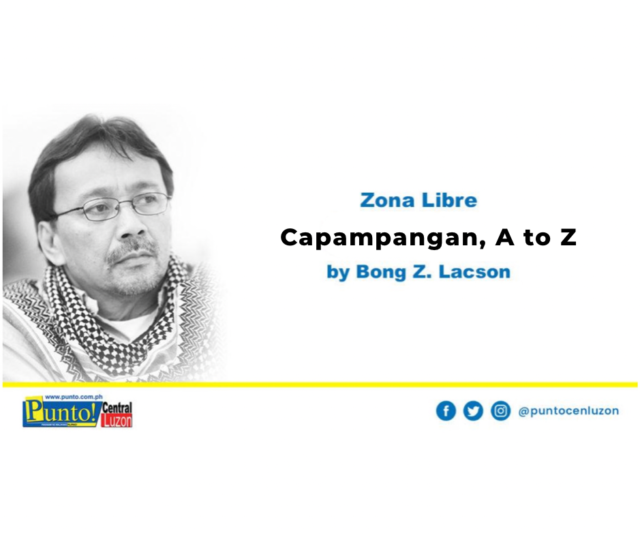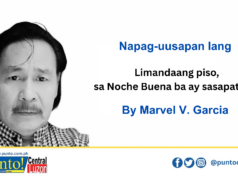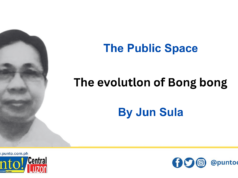FRIDAY, December 11, marks the 449th year of Pampanga’s founding as a province, the first in the entire island of Luzon, by the Spanish conquistadores.
With the coronavirus disease pandemic constraining all official observance of the day to virtual, reflective (un)realities of the FB page, I dug up my archives of celebratory pieces of Aldo ning Kapampangan past. If only to have that feel, that pride the day invariably stirs.
Here’s a rehash of top-of-mind randomness on everything and anything Capampangan with the letters of the alphabet as only guide for some semblance of order.
Arayat, naturally comes first. The mountain that lords over the plains of Central Luzon impacts the majesty, if not the primacy, of the province over the rest of the region. Abe, dear friend, doubled to oneness in abe-abe, so central in the vocabulary as in our character as a distinct race, as we have long elevated ourselves to be. Augustinians, the harbingers of the Faith enshrined as much in the hearts and souls of the native Capampangans as in their magnificent churches.
Betis, arguably the church with the most Sistine Chapel-like ceiling in all the Philippines. Bacolor, once serving as the capital of Las Islas Filipinas at the time of the British Occupation off Manila in the early 1760s. Buru –fermented rice with fish or shrimps – pungent but ambrosiac, no true Capampangan can do without. Betute
Clark. Once the bastion of American imperialism in the Asia-Pacific as host to the largest US military installation outside continental USA, now a bustling freeport with the long-promised modern airport terminal soon to open.
Dugong aso. Long (mis)impressed as backbiting treachery, in actuality referencing to dogged devotion, okay, canine loyalty. Don Perico. Traitor to his landowning class, he fathered socialism in the Philippines, and – to me – equals in greatness the martyrdom of his brother, Chief Justice Jose Abad Santos.
Ebun, principal agro-product that formed one half of Candaba town’s iconic festival, cause of the province’s economic woes whenever avian flu comes a-calling. Everybody’s Café, unarguably serving the best in home-cooked Capampangan dishes, major contributor to Pampanga being hailed the Culinary Capital of the Philippines.
Furniture and furnishings, from the antique to the “antiqued” that gave the world “Betis Baroque” to exotic rattan, metal and cast-iron, all crafted exquisitely by the country’s best artisans.
GMA. Love her. Hate her. But there’s no denying the economic fundamentals instituted during her watch did the nation good. And she still won elections, despite her incarceration, er, hospital arrest, with or without her neck brace. Senator, vice president, president, congresswoman, House speaker – no other human hastrod and triumphed through that all.
Hot air balloon. Once the only thing Clark was good at. Now, much better off in Lubao. Go, ask the balloonists themselves. H – in the Capampangan tongue – silent where present, stressed where absent. As in hay ev ha aws hin onolulu, awaii.
Ilustrado, the social class to which every Capampangan assumes himself/herself as belonging to, no matter his/her socio-economic condition. With outward manifestation in his/her being –
Japorms, showy but chic in style and fashion, ever dressed to the nines even when the pocket holds but a dime.
Kamaru, mole cricket, invariably cooked deep-fried adobo. Reputedly an aphrodisiac for the Capampangan macho.
Leguan – a living, walking celebration of beauty is the Capampangan woman, as the local ditty puts it aptly, aro catimyas na nitang dalaga…
Mequeni – a most welcoming invitation as much to the home as to the heart of the Capampangan.
Nanay. Motherhood becoming the best practice of provincial governance. Nang, a multifaceted word in Capampangan, best exemplified in Nang nanangnang ng ‘Nang? Straight translation: What is being grilled by mom?
O’t. What other dialect, or language for that matter, possesses a word comprising two letters conjoined by an apostrophe? O’t macanyan ca? O’t balamu matudtud ya mu ing meangu bie.
Parul¸ the Christmas lantern that is both shibboleth of our faith as Catholics and our culture and craftsmanship as Capampangan taken to gigantic proportions with the City of San Fernando’s signature festival. Pinatubo, from which devastating eruption triumphed, excelled, soared the Capampangan spirit to greater heights of development and glory. Presidents, three of whom the Capampangan race contributed to the Republic – GMA, her father Apung Dadong, and the widow in yellow, Cory Cojuangco–Aquino.
Qng, queca, queni, quibal, quiao-quiao, calaquian, tuquil… the Q in Capampangan words losing to the Tagalog’s K. What gives?
Religious, the first Filipino priest and nun were Capampangans. So was the first Filipino cardinal. And yes, the self-proclaimed “Appointed son of God” who claimed he stopped the earthquake is Capampangantoo. Rebellious, the first major, major revolt against the Spaniards was by the Capampangan Francisco Maniago. Yeah, the province birthed and bred rebel armed groups from the Huks to the New People’s Army.
Sinukwan, the deity-king of the ancient Capampangans celebrated in December’s other festival in the capital city. Sisig, hailed as the best pork dish in the world.
Tarik Soliman, the young boy from Macabebe. Wikipedia says was “the first warrior-hero who died for our freedom.”
Universities, at least seven in Pampanga, plus scores of colleges and other higher institutions of learning, making the province a center of education in the whole region.
Virgen de los Remedios, the beloved patroness of Pampanga, whose image, with the Santo Cristo del Perdon, is taken from town to town in a crusade of penitence and charity.
Wetlands, particularly the Candaba Swamp, where the annual migration of birds from temperate countries has put the province in the world wildlife map.
X, not for the cinematic rating but for the expletives easily rolling out of the Capampangan mouth. As in bolang, buguk, tigtig, luse, murit, turak, sira buntuc just for crazy.
Yabang, the single characteristic that defines the Capampangan most, among other ethnicities, er, tribes, er, other Filipinos.
Zest for life. Joie de vivre best expressed in Oyni’ng bie!
Luid ya ing Capampangan!





